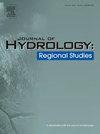Enhancing the accuracy and generalizability of reference evapotranspiration forecasting in California using deep global learning
IF 4.7
2区 地球科学
Q1 WATER RESOURCES
引用次数: 0
Abstract
Study region
This research focuses on the Central Valley of California, a climatically homogeneous region known for its significant agricultural productivity and reliance on extensive irrigation. Our study utilizes monthly reference evapotranspiration (ETO) time series data from 55 standardized weather stations as part of the California Irrigation Management Information System (CIMIS).
Study focus
ETO is a critical component of regional water cycles, indicating atmospheric water demand. This study evaluates the potential of deep learning (DL) models for ETO forecasting, particularly emphasizing the efficacy of a global learning scheme compared to traditional local learning. Global learning involves training forecasting models on pooled data from multiple time series, tested over new instances. We compared the performance of statistical models and advanced DL models, demonstrating significant accuracy enhancements in global learning schemes. We also explored automatic hyperparameter optimization for these models to achieve state-of-the-art forecasting accuracy, yielding RMSE values below 10 mm/month for one-year-ahead forecasts on new, unseen stations.
New hydrological insight for the region
Applying global learning methodologies to DL models markedly improved forecasting performance, showcasing an ability to generalize findings to ungauged regions and even newly established weather stations. This suggests a promising avenue for enhancing water resource management efficiency in data-scarce areas. Our findings argue that such data-centric methodological shifts could play a critical role in better managing the irrigation demands of the Central Valley, thereby supporting sustainable water usage and agricultural productivity in the region.
求助全文
约1分钟内获得全文
求助全文
来源期刊

Journal of Hydrology-Regional Studies
Earth and Planetary Sciences-Earth and Planetary Sciences (miscellaneous)
CiteScore
6.70
自引率
8.50%
发文量
284
审稿时长
60 days
期刊介绍:
Journal of Hydrology: Regional Studies publishes original research papers enhancing the science of hydrology and aiming at region-specific problems, past and future conditions, analysis, review and solutions. The journal particularly welcomes research papers that deliver new insights into region-specific hydrological processes and responses to changing conditions, as well as contributions that incorporate interdisciplinarity and translational science.
 求助内容:
求助内容: 应助结果提醒方式:
应助结果提醒方式:


